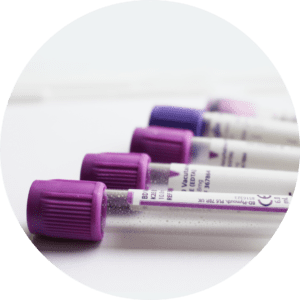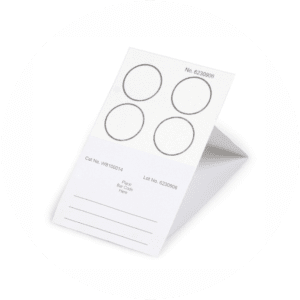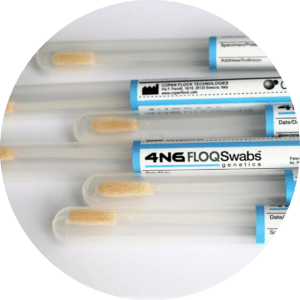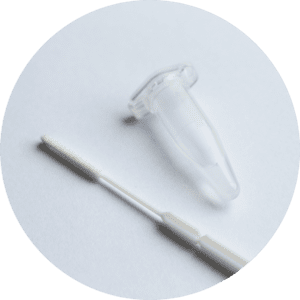Blood sampling
 Venous blood in the volume of 4.5 - 5 ml must be provided for the study. Blood is drawn into vacutainers with EDTA (special tubes containing anticoagulant) or regular disposable tubes, in which the anticoagulant solution is poured beforehand. The anticoagulant is 0.5M EDTA solution, pH 8.0. The ratio of EDTA volume to blood volume should not exceed 1:10. Sodium citrate solution can be used. The use of heparin is strictly prohibited!
Venous blood in the volume of 4.5 - 5 ml must be provided for the study. Blood is drawn into vacutainers with EDTA (special tubes containing anticoagulant) or regular disposable tubes, in which the anticoagulant solution is poured beforehand. The anticoagulant is 0.5M EDTA solution, pH 8.0. The ratio of EDTA volume to blood volume should not exceed 1:10. Sodium citrate solution can be used. The use of heparin is strictly prohibited!
After the blood has been drawn, the tube must be corked and gently turned upside down several times so that the blood in the tube is thoroughly mixed with the anticoagulant.(NB! Otherwise the blood will curdle and the extraction of DNA from it will be difficult, the DNA in the obtained preparation will be partially destroyed!)
On the tube on a special adhesive tape or strip of medical plaster should be clearly written with a pen, the name, initials and status of the person whose blood is in the tube (for example, Ivanov I.I., father of the patient). The tube must necessarily be accompanied by a referral, which clearly indicates the name of the patient, type of study, who and where sent to the laboratory, as well as a schematic representation of the family tree, indicating the names of all family members from whom the blood was collected.
Dry blood sampling on a filter or gauze
 - Place a disc of filter paper or a non-sterile bandage folded in 5 layers into a sterile Petri dish.
- Place a disc of filter paper or a non-sterile bandage folded in 5 layers into a sterile Petri dish.
- Perform venous blood sampling.
- Pour the blood sample onto the filter paper/sterile gauze to make a spot at least 3-4 cm in diameter. The blood should soak through the filter paper/sterile bandage disc.
- Dry the filter paper disc/tape in a ventilated room, away from heating appliances and UV light (UV lamps, incandescent lamps, sunlight) for 24 hours.
After drying, the sample should be packed in an individual paper envelope and can be stored at room temperature for several years, being suitable for DNA extraction. The envelope should be signed. It is unacceptable for anyone other than the patient being tested to touch the blood stain or the carrier item where the blood stain will be before it is obtained to avoid obtaining incorrect results.
Buccal epithelium sampling
 When these samples are taken using a special disposable instrument (wand) provided by Trigen Laboratories, epithelial cells are scraped from the inner surface of the cheek according to the following procedure:
When these samples are taken using a special disposable instrument (wand) provided by Trigen Laboratories, epithelial cells are scraped from the inner surface of the cheek according to the following procedure:
- The client from whom the samples will be taken should rinse his/her mouth with clean, boiled water.
- Take the wand by the handle without touching the white tip and run the end of the wand with the tip on the inner surface of the cheek at least 10 times with gentle pressure.
- Place the used wand with the nozzle neatly in a paper envelope or in a test tube provided by the Contractor.
At least three specialized sticks (a main stick and two control sticks) with a buccal epithelium sample must be provided from each client. Store and transport samples in paper envelopes at room temperature. Samples from different clients should be in separate envelopes to avoid mutual transfer of biological material. Download instructions>>>
Urogenital biomaterial sampling for PCR infections

Biological sampling, if possible, should be performed during the exacerbation of the infection. Biological material should be sampled strictly before the start of antibacterial and chemotherapeutic agents or not earlier than 10-14 days after their withdrawal.
Women on the eve of the test for infections, should not perform sprinkling, use suppositories, gels with antiseptic action. At least 3 hours should pass from the last urination to the collection of the material.
Biological material for examination must be taken in the necessary and sufficient volume (the size of a matchstick), ensuring that it is not contaminated by resident microflora. The amount of material taken for the study should not be excessive, because along with the pathogen in the sample enter substances that can inhibit PRC or may contribute to the degradation of DNA during storage and transportation.
An insufficient amount of material can determine a false-negative result of the study. To control the effectiveness of the study, biomaterial collection should not be carried out earlier than 3-4 weeks after the end of therapy.
The most adequate instrument for taking smears and scrapes for PCR analysis is a special disposable urogenital probe (brush), which collects the necessary amount of epithelium without traumatizing the mucosa, almost does not absorb the sample and gives the collected material well into the liquid transport medium.
The biological material sampled must be labeled. The accompanying referral document must indicate in block letters: gender, name, surname, patronymic, age of the patient, presumed diagnosis or indications for examination, date of sampling, which institution sends the material.
Take clinical material, strictly following the instructions, only with sterile disposable instruments in sterile disposable vials, tubes, containers. Wear disposable gloves.
Immediately after collection, tightly close test tubes, vials with clinical material without touching their inner surface and the inner surface of the lids.
Rules for taking material from women
Rules for taking scraped cervical canal material
The cervical canal is accessed using a disposable or reusable sterile gynecological speculum. Material is taken with a cervical cytobrush (urogenital probe) into a tube with a special transport medium.
Remove mucus and vaginal discharge from the surface of the cervix with a sterile gauze swab, insert the working part of the cytobrush (urogenital probe) into the cervical canal and make 2-3 full clockwise rotations.
Remove the cytobrush (of the urogenital probe) and place its working part containing the taken material into the tube with the transport medium. Press the working part of the cytobrush against the wall of the tube and remove it, close the lid of the tube tightly.

Rules for taking material from men
To diagnose urogenital infections in men, a scraped urethral examination, first batch urine, prostate secretion and/or ejaculate are examined.
Rules for taking material from scraped urethral examination.
Before taking a scrape, treat the penile head in the area of the external opening of the urethra with sterile saline solution. If there are free-flowing secretions from the urethra, remove them with a dry tampon. The urethra is massaged.
The probe is inserted to a depth of 1-2 cm. Several rotary movements make scraping of epithelial cells and transfer the probe to the tube with the transport medium, transfer the working part of the probe to the medium and, having pressed it to the inner wall of the tube, rotate the probe for 5-10 seconds, after which the probe is removed and the tube is tightly closed.

